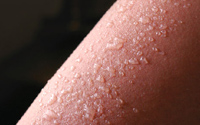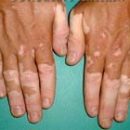In the process of radiation therapy, radiation affects not only the affected organ, but also on the superficial skin. Therapeutic radiation doses cause dryness, redness of the skin and the formation of blisters. However, side effects after discontinuation of treatment are gradually reduced.
Content
The effects of radiation therapy
Many people are afraid of radiation. They believe that therapeutic doses of irradiation can be dangerous, as, for example, an explosion of an atomic bomb or an accident at a nuclear power plant. Whatever treatment is effective, it is almost always accompanied by side effects. This statement is true for radiation therapy. At the same time, the reaction to the radiation therapy for each person will be different, so to predict how to transfer the exposure to a specific patient - to say difficult.
Often among patients with oncological diseases circulate all sorts of rumors, «truthful» History and Baiks on Radiation Cunning. Therefore, it is very important to understand that there is no connection between therapeutic (so-called therapeutic) doses of radiation and that radiation, which happens with atomic explosions. Radiation, which is designed to combat cancer controlled, targeted and safe.
In the process of radiation therapy, most patients find out that radiation irradiation is not so terrible as it seemed to them. Although, it should be remembered that radiation, killing cancer cells, can have a damaging effect on normal cells. And since the effect of irradiation arises gradually, then, accordingly, side effects are gradually developing.
However, it should be noted that it is not at all necessary that absolutely all patients suffer equally from these side effects. Knowing about them and prepared for these side effects you can minimize discomfort during treatment. A few weeks after the end of the exposure course, all these side effects gradually pass.
Skin reaction
Most often radiation causes a reaction from the skin. This is manifested by discomfort in the irradiated area. In most cases, the skin reaction to radiation is manifested as a sunburn, in the form of redness of the skin, itching, burning, soreness and sometimes peeling. But in contrast to sunburn, the skin reaction to radiation occurs gradually and usually in some areas. During radiation therapy, the first thing that may notice the patient is a change in the color of the skin with pink to red. At the same time, some skin sections can be more intense color. Skin reaction can be a moderate and limited radiation zone. In some cases, the skin reaction to irradiation may be more pronounced and occupy a large area of the irradiated organ. This, mostly, it happens when the patient has bright leather, which is very susceptible to sunburn burns.
As with sunburn, the skin can be dry, painful and very sensitive to touch. At this time, irritation may increase. The skin can peel, like an old sunburn or to form blisters. Such peeling is usually limited to several skin sections. If the blister revealed, the disease and mocking area is exposed. If you do not start care of such a section of the skin in a timely manner, infection can join and the situation will be aggravated by.
A way to reduce the manifestations of skin reactions to irradiation is wearing free, not tightly adjacent clothes, preferably from cotton material.
 Gradually, on the affected area there are areas of new skin of pink color. New skin is usually very gentle. Such skin can grow either under blister, or under old, dry, peeling skin. It is not recommended to cut such blisters or scrape old skin, as they protect newly growing skin. In the event that the problem becomes especially pronounced, the doctor can make a small break in the treatment in order to recover the skin.
Gradually, on the affected area there are areas of new skin of pink color. New skin is usually very gentle. Such skin can grow either under blister, or under old, dry, peeling skin. It is not recommended to cut such blisters or scrape old skin, as they protect newly growing skin. In the event that the problem becomes especially pronounced, the doctor can make a small break in the treatment in order to recover the skin.
Typically, such changes from the skin occurs gradually and with a weekly inspection by a doctor you can warn them. Fortunately, skin irritation by radiation is temporary. In most cases, the doctor prescribes certain ointments, medicines in order to mitigate the skin reaction.
After the radiation therapy rate is completed, the negative effects of the skin can still be observed for one to two weeks, after which they are gradually starting to pass. Natural skin color will come back a little longer. And for six months or longer. The patient may noted that the irradiated areas of the skin are somewhat darker or vice versa more pink than usual. In some patients, a dark shade of irradiated areas can occur even more than a year after treatment. In some cases, thin blood vessels may be celebrated on the irradiated areas of the skin. These are the so-called vascular stars or teleangectasia. These vasculars are in no way signs of recurrence of the disease. Unfortunately, they do not pass by themselves, and it may be necessary to help the Vascular Surgeon.
Useful tips for radiation therapy
Several tips for those who pass radiation therapy:
- During treatment it is recommended to avoid sunlight on the irradiated area
- Wear clothes with a high collar
- Always wear clothes
- We recommend wearing loose clothes, you can even size more, which creates coolness for the skin and does not irritate the irradiated areas
After the course of radiation therapy is completed, it must be remembered that the irradiated areas of the skin can now become more sensitive to sunlight, and, consequently, burns. Therefore, before reaching the sun (for example, on the beach), take a bath, shower or swimming in the pool It is recommended to use special creams that have a sunscreen effect and help avoid irritation with chlorinated water.









